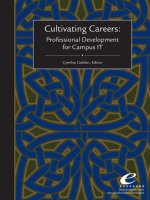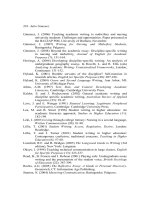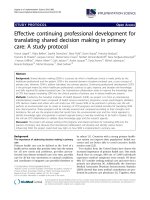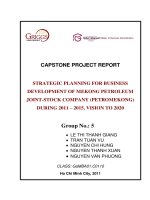OHIO STANDARDS FOR PROFESSIONAL DEVELOPMENT APRIL 2015 10 ĐIỂM
Bạn đang xem bản rút gọn của tài liệu. Xem và tải ngay bản đầy đủ của tài liệu tại đây (832.24 KB, 10 trang )
<span class="text_page_counter">Trang 1</span><div class="page_container" data-page="1">
Standards for
APRIL 2015
</div><span class="text_page_counter">Trang 2</span><div class="page_container" data-page="2"><b>Introduction </b>
All of Ohio’s educators and parents share the same goal – that Ohio’s students learn at the highest levels possible and be prepared for the demands of the future. Research shows that teachers have a tremendous impact on student learning, and that the schools in which they operate impact teachers. A strong relationship exists between educational leadership, professional learning, teaching knowledge and practices, and student results. Creating a system of effective professional learning is one way that school systems can support all educators, and encourage improved teaching and learning. Through ongoing professional learning, educators gain the new knowledge, skills and ideas that allow them to best meet students’ learning needs.
<b>THE UPDATING OF OHIO’S STANDARDS FOR PROFESSIONAL DEVELOPMENT </b>
During the 2005-2006 school year, the Ohio Educator Standards Board presented its first set of
<i>Standards for Professional Development in the publication Organizing for High Quality Professional </i>
<i>Development. The board, a group of educators representing teachers and university education faculty </i>
statewide, began updating the standards in the 2013-2014 school year. The goal of this work was to ensure the standards reflect the nation’s expanding
knowledge about the elements of effective professional learning.
<i>During the updating process, the Standards for </i>
<i>Professional Learning developed by the international </i>
nonprofit education association Learning Forward served as a leading resource. By adapting and integrating Learning Forward’s standards into Ohio’s benchmarks, our state joins many others in benefitting from the collective wisdom of numerous experts in the
field of professional learning and the collaboration with education associations, organizations and agencies. The Ohio Standards for Professional Development define the essential elements of a strong professional learning system. The Educator Standards Board recommended that the State Board of Education of Ohio adopt these standards.
<b>GUIDELINES FOR A SUCCESSFUL PROFESSIONAL LEARNING SYSTEM </b>
To be effective in increasing educator effectiveness and student learning, a system of professional learning must:
<i> Occur within a collaborative culture in which all share collective responsibility for continuous </i>
improvement.
Be advanced by leaders who prioritize professional learning and develop the capacity and structures to support it.
Be supported by resources.
Be data-based, and use data for planning, assessment and evaluation.
Represent best-practice models and theories of adult learning and active engagement.
Be research-based, using what is known about change to sustain implementation.
Focus on specific goals and align outcomes with existing educator and student standards.
</div><span class="text_page_counter">Trang 3</span><div class="page_container" data-page="3">Simply adopting these standards does not ensure success. Instead, effective school systems must commit to them by creating a culture of inquiry, in which all feel a shared responsibility and a
commitment to continuous improvement. In these systems, educators will practice collaboration and shared leadership, and support meaningful professional learning with adequate resources. Successful implementation will occur within a system of accountability, focused on measurable data and results.
<b>ORGANIZATION </b>
The Ohio Standards for Professional Development include seven standards:
<b>Standard 1: Learning Communities </b>
<b> The elements are the statements of the characteristics of </b>
effective professional learning.
<b> The indicators show the observable and measurable actions that </b>
educators must take to implement a system of effective professional learning.
<b>INTENDED AUDIENCES </b>
<i>The Ohio Standards for Professional Development articulate the conditions, processes and content </i>
required for an effective system of professional learning. Users of Ohio’s standards will see that the standards are written from a systems perspective – to describe what occurs within an effective system of professional learning. The standards are not written from the perspective of a single leader or an individual educator but, rather, they describe the overall elements essential for success. As such, their primary audience will be those responsible for implementing systems of professional learning in their schools or districts. The standards are written for multiple audiences including planners, providers, participants and evaluators of professional learning. Individuals and organizations will find them useful in the following ways.
<b>Individual Educators </b>
The standards will guide educators in designing their individual plans for
professional learning and identifying effective professional learning opportunities.
<b>Principals </b> The standards will guide principals in designing their individual plans for professional learning and working to ensure that their schools offer effective systems of professional learning.
<b>School and District Leaders </b>
School and district leaders responsible for designing, implementing and evaluating systems of professional learning should use the standards to design, implement and evaluate the system’s professional learning program.
<b>Higher </b> Members of higher education institutions should plan course offerings for educators
</div><span class="text_page_counter">Trang 4</span><div class="page_container" data-page="4"><b>External Vendors </b>
External vendors of professional learning should use the standards to ensure that they offer Ohio educators high-quality professional learning opportunities.
<b>Local </b>
<b>Professional Development Committees </b>
Members of local professional development committees can use the standards to help educators create individual plans and to evaluate the plans of individual educators.
<b>HOW TO USE THE STANDARDS </b>
The Ohio Standards for Professional Development set clear expectations for professional learning in the state’s schools and districts. Individual educators, teams, school and district staff may use the standards to guide their efforts in selecting and evaluating professional learning opportunities. Institutions of higher education, external vendors and other educational providers also will find the standards beneficial as they establish policies and opportunities for professional learning.
The standards are not a recipe book for how to create a specific professional learning system locally. Rather, the standards and other resources from the Ohio Department of Education and Learning Forward are resources districts should use as they work together in small groups to develop effective systems and processes that meet their needs.
The following offer suggestions for how educators serving in a variety of roles can use the standards to support effective professional learning. Each individual can:
Study the standards to develop knowledge of effective professional learning practices and become stronger advocates for effective professional learning.
Evaluate professional learning opportunities with the standards, to identify standards-supported opportunities and request improvements in other existing professional learning opportunities.
Apply the standards to the planning, design, facilitation and evaluation of professional learning they lead.
</div><span class="text_page_counter">Trang 5</span><div class="page_container" data-page="5"><b>Ohio Standards for Professional Development Standard 1: Learning Communities </b>
Professional learning that increases educator effectiveness and results for all students…occurs within
<b>learning communities committed to continuous improvement, collective responsibility and goal alignment. </b>
Effective professional learning takes place within a system, with a culture of collaboration and shared responsibility. In an effective system, all members are focused on a cycle of
continuous improvement, which maintains its focus on a set of targeted goals that align with larger school and system goals. For some school systems, meeting this standard may require a conceptual or cultural shift. For others, it may simply require a greater focus on specific steps in a cycle of continuous improvement or greater support for collective participation in
<b>1.1.1 Develop capacity to apply a cycle of continuous improvement. </b>
Use data to determine student and educator learning needs;
Specify targeted, shared goals for student and educator learning;
Offer and support professional learning that extends educators’ knowledge of content, content-specific pedagogy, how students learn and management of classroom environments;
Select and implement evidence-based strategies to achieve focused student and educator learning goals;
Support application of learning with local support at the work site;
Use evidence to monitor and refine implementation; and
<b>1.2.1 Create a culture of inquiry in which all members share a collective </b>
responsibility for students’ success.
<b>1.2.2 Foster engagement of and collaboration among all staff in meeting the </b>
needs of students, including their social, emotional, mental and learning needs.
<b>1.3 Create </b>
<b>alignment and accountability. </b>
<b>1.3.1 Specify targeted, shared goals for student and educator learning. 1.3.2 Align professional learning with individual, school and system goals </b>– including the Ohio educator and student standards.
</div><span class="text_page_counter">Trang 6</span><div class="page_container" data-page="6"><b>Standard 2: Leadership </b>
Professional learning that increases educator effectiveness and results for all students…requires
<b>skilled teacher leaders and administrators who develop capacity, and advocate and create support systems for professional learning. </b>
Leaders in an effective professional learning system may be found at the classroom, school or system levels. What these leaders share is the belief that professional learning is key to increasing student results – and, as a result, learning is among their top priorities. Effective leaders maintain a persistent focus on educator professional learning. They develop expertise among others in the community and create the systems and structures needed to enable learning. For some school systems, meeting this standard may require structural shifts. For others, it may require clearer articulation of the role of professional learning on student results or a more targeted focus on developing skills for shared leadership, collaboration and effective participation in learning communities.
<b>2.1.1 Develop capacity among educators for leadership of professional </b>
learning – including the building of knowledge for collaborating in teams successfully.
<b>2.1.2 Understand and use best-practice research and the Standards for </b>
Professional Learning in making decisions about professional learning.
<b>2.2 Advocate for professional learning. </b>
<b>2.2.1 Articulate the link between student learning and professional learning. 2.2.2 Advocate high-quality professional learning by promoting learning with </b>
staff, students, parents, system leaders, public officials and community members and challenging ineffective practices.
<b>2.3.1 Establish systems and structures for effective professional learning. 2.3.2 Prepare and support staff for skillful collaboration. </b>
<b>2.3.3 Contribute to the development and maintenance of a collaborative </b>
culture.
<b>2.3.4 Create learning communities that offer all educators the chance to share </b>
ways of improving teaching and learning as they work in small teams organized by grade, subject, roles, interests, goals or other areas of responsibility.
<b>Standard 3: Resources </b>
Professional learning that increases educator effectiveness and results for all students…requires
<b>prioritizing, monitoring and coordinating resources for educator learning. </b>
To achieve goals, effective professional learning requires human, fiscal, material and technological resources – and time. Resources may come from many sources – including partnerships with institutions of higher education, as well as allocations from government, public and private agencies and educators themselves. Making decisions about resource allocation requires a clear understanding of available resources, a thoughtful consideration of priorities and creative thinking about ways to embed learning into educators’ practice. Once resources have been allocated, tracking and monitoring these resources to evaluate their effectiveness is an essential step to ensure that thoughtful decisions are made in how to allocate, adjust and coordinate resources.
</div><span class="text_page_counter">Trang 7</span><div class="page_container" data-page="7"><b>3.1.1 Define internal and external resources for professional learning, including </b>
staff, materials, technology, funding, time and partnerships (such as with
<b>institutions of higher education and external vendors). </b>
<b>3.1.2 Recommend resources to align professional learning with high-priority </b>
<b>student and educator learning needs and to support implementation. </b>
<b>3.1.3 Allocate time for collaborative professional learning within the schedule. 3.2 Monitor </b>
<b>resources. </b>
<b>3.2.1 Monitor effectiveness and efficiency of the use of resources for </b>
professional learning by reviewing data and adjusting direction of resources as needed.
<b>3.3 Coordinate resources. </b>
<b>3.3.1 Design and implement a comprehensive, professional learning resource </b>
plan, which includes repurposed resources, schedules, technology, internal and external human resources and grants or other funding sources.
<b>Standard 4: Data </b>
Professional learning that increases educator effectiveness and results for all students…requires the
<b>use of a variety of sources and types of student, educator and system data to plan, assess and evaluate professional learning. </b>
To have a balanced and comprehensive view of student, educator and system performance, educators must collect, analyze and interpret multiple sources of quantitative and qualitative data. Sources for this data might include formal and informal measures, such as demographics of student populations, the results of the Ohio Principal and Teacher Evaluation Systems, formative and summative assessments, performance assessment results, observations, samples of work, portfolios and self-reports of educator needs. Data plays a role in informing the goals for professional learning, allowing systems to accelerate and continue educator growth and provide
support as needed. In addition, data is essential in evaluating progress and outcomes of professional learning. The process of analyzing data can be professional learning in and of itself for educators who work in teams to analyze student work or design shared assessments. Ongoing data collection informs and sustains a cycle of continuous improvement.
<b>4.1.1 Develop capacity to analyze and interpret data. </b>
<b>4.1.2 Analyze and interpret multiple sources of qualitative and quantitative </b>
student data
educator data
school and system data
to determine professional learning needs.
<b>4.2 Assess progress. </b>
<b>4.2.1 Determine formative data to assess progress toward professional learning </b>
benchmarks and goals.
<b>4.2.2 Collect, analyze and use formative data to continuously assess progress </b>
</div><span class="text_page_counter">Trang 8</span><div class="page_container" data-page="8"><b>Elements Indicators </b>
toward professional learning benchmarks and goals.
<b>4.2.3 Use analysis of progress to make adjustments in professional learning, </b>
including solving problems, changing learning designs or coaching and support systems, activities and timeframes.
<b>4.3.2 Use a variety of formative and summative data to evaluate professional </b>
learning’s effectiveness and impact on student performance, professional practice, school culture and organizational structures.
<b>4.3.3 Support the use of data by facilitating data review and analysis to evaluate </b>
the effectiveness of school wide learning designs, content and duration.
<b>4.3.4 Use evaluation results to improve professional learning. </b>
<b>Standard 5: Learning Designs </b>
Professional learning that increases educator effectiveness and results for all students…integrates
<b>theories, research and models of human learning to achieve its intended outcomes. </b>
Research has revealed much about how people learn, and educators should use this information to design high-quality professional learning that will impact teaching and student achievement. The use of multiple designs for learning are supported by evidence and while they differ, they share features such as active engagement, modeling of new techniques or practices; opportunities for application,
reflection, self-assessment and feedback; and monitoring and support during implementation.
Successful professional learning can occur within the school day or outside of it; take place in face-to-face, online or hybrid settings; can be focused on individuals or on groups; and can vary in terms of level of structure. Most effective systems will incorporate multiple learning designs. For some systems, a consideration of effective designs may result in an expansion of what is viewed as professional learning. For example, collaborating with colleagues, analyzing student data, observing peers,
examining student work and designing shared lessons or assessments are all job-embedded designs that can result in professional learning.
<b>5.1.1 Develop and share a knowledge base about theories, research and </b>
models of adult learning.
<b>5.1.2 Acquire and share knowledge about multiple designs for professional </b>
learning, such as peer coaching, collaborative learning communities, action research and the examination of student work.
<b>5.2 Select </b>
<b>learning designs. </b>
<b>5.2.1 Acquire, share and apply knowledge of learning designs, including </b>
technology-based designs, when considering multiple factors to select effective designs for professional learning.
<b>5.2.2 Develop and share knowledge about technology-enhanced learning </b>
</div><span class="text_page_counter">Trang 9</span><div class="page_container" data-page="9"><b>Standard 6: Implementation </b>
Professional learning that increases educator effectiveness and results for all students…applies
<b>research on change and sustains support for implementation of professional learning. </b>
When systems have in place the foundational elements for professional learning, they must then take action. Knowing is not the same as doing. To change educator practice and increase student learning
takes time and requires an understanding of change. Creating meaningful changes in professional practice requires an attention to possible barriers as well as ongoing feedback and support to reduce these potential roadblocks. As they work to implement new knowledge and skills, school districts can support educators formally and informally; individually or through learning
communities or teams; through coaching or peer support; and through materials, resources and models.
Constructive feedback and opportunities for reflection can ensure that educators continue to move higher on the continuum of their practice.
<b>6.1 Apply change research. </b>
<b>6.1.1 Build knowledge of research on change. </b>
<b>6.1.2 Apply research on change to plan and lead the implementation of </b>
professional learning.
<b>6.2 Sustain implementation. </b>
<b>6.2.1 Differentiate support for implementation of professional learning. 6.2.2 Continue support to reach high-fidelity implementation of professional </b>
learning.
<b>6.3 Provide constructive feedback. </b>
<b>6.3.1 Develop capacity to give and receive constructive feedback. </b>
<b>6.3.2 Provide constructive feedback to accelerate and refine implementation </b>
of professional learning.
<b>Standard 7: Outcomes </b>
Professional learning that increases educator effectiveness and results for all students…aligns its
<b>outcomes with educator performance and student curriculum standards. </b>
Student and educator standards specify what students and educators should know and be able to do. By aligning professional learning with these high expectations for students and educators, the link between educator learning and student learning becomes explicit. Making these
connections creates a coherent system in which activities for professional learning do not take place in isolation. Instead, opportunities for learning are purposeful and focused on clear goals, specific contexts and demonstrated areas of need.
</div><span class="text_page_counter">Trang 10</span><div class="page_container" data-page="10"><b>Elements Indicators 7.1 Meet </b>
<b>performance standards. </b>
<b>7.1.1 </b>Use Ohio’s educator standards to identify professional learning needs.
<b>7.1.2 </b> Use Ohio’s educator standards to make decisions about the content of
<b>7.2.3 Offer and support professional learning that extends </b>educators’ knowledge of content, content-specific pedagogy, how students learn and management of classroom environments.
<b>7.3 Build coherence. </b>
<b>7.3.1 Connect professional learning with building, local and statewide initiatives. 7.3.2 Contextualize professional learning, building on earlier professional </b>
learning and bridging to planned future experiences.
<small>The Ohio Educator Standards Board, the State Board of Education and the Ohio Department of Education do not recommend or endorse any specific for-profit professional learning program for use by educators. The updated Ohio Standards for Professional Development present educators with benchmarks for selecting, evaluating and designing professional learning opportunities that meet high-quality criteria. </small>
</div>








